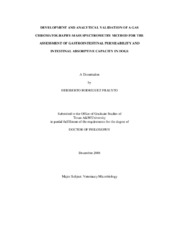| dc.description.abstract | Assessment of gastrointestinal permeability in vivo is considered a suitable
method for the evaluation of gastrointestinal mucosal integrity. Probes commonly used
include lactulose (L) and rhamnose (R) for the assessment of intestinal permeability,
xylose (X) and 3-O-methylglucose (M) for the evaluation of intestinal absorptive
capacity, and sucrose (S) for the assessment of gastric permeability. Traditionally,
various methods have been used to quantify these markers in the urine after orogastric
administration. However, urine collection is difficult and uncomfortable. A protocol
based on the analysis of blood samples would be easier to perform. Thus, the aim of the
first part of this project was to develop and validate a new gas chromatography-mass
spectrometry (GC-MS) method for the quantification of five sugar probes in canine
serum. The method was sensitive, accurate, precise, and reproducible for the
simultaneous quantification of 5 sugar probes in serum. The aim of the second part of
this project was to assess the kinetic profiles of these 5 sugar probes in serum after
orogastric administration in dogs and to determine the optimal time point for sample
collection. Dogs received a solution containing L (10 g/L), R (10 g/L), X (10 g/L), M (5
g/L), and S (40 g/L) by orogastric intubation. Baseline blood samples were collected.
Subsequent timed blood samples were taken for a 24 hours period. Significant changes in
serum concentrations of all 5 sugars were detected after administration of the test dose
(p<0.0001 for all 5 probes). Serum concentrations of L and R were significantly different from baseline concentrations from 90 to 240 and from 60 to 300 min post dosing
respectively, and those of X, M, and S were significantly different from 30 to 240 min
after dosing (p<0.05 for all 5 probes). Variations of the mean sugar concentrations of all
dogs at 90, 120, and 180 minutes were analyzed using a Kruskal-Wallis test. Based on
the results, only two blood samples, one taken at baseline and a second sample obtained
between 90 and 180 after dosing, appear to be sufficient for assessment of intestinal
permeability and mucosal absorptive capacity using these sugar probes. | en |


